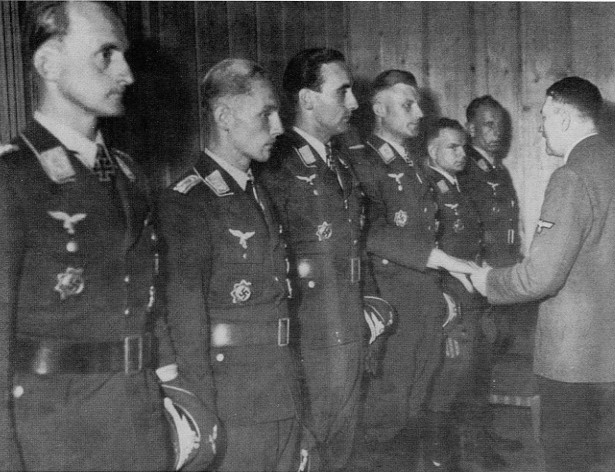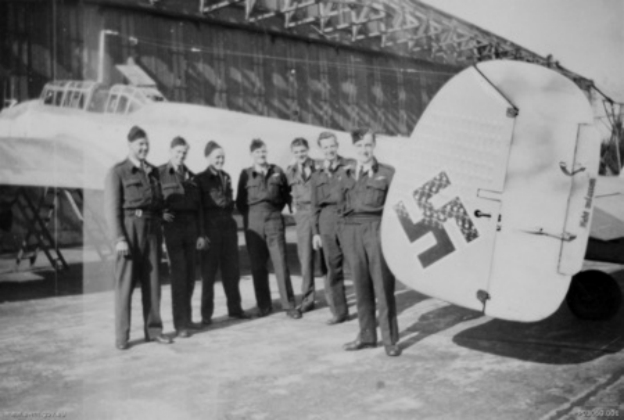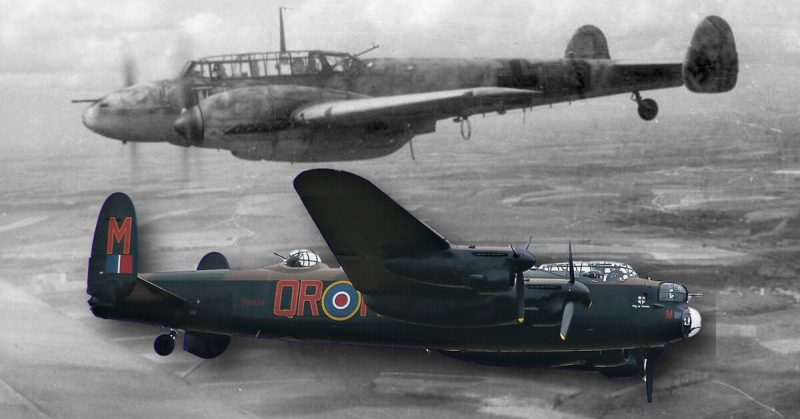Once you know the story of Heinz-Wolfgang Schnaufer, it’s pretty hard to forget. Schnaufer was an incredibly skilled pilot. He was arguably the best night fighter pilot in the war.
Simply put, this German fighter pilot was the deadliest night fighter ace in history – with 121 confirmed kills. He also survived the whole war and only met his death when he was killed in his car by a drunk truck driver while on his way to purchase wine in Bordeaux.
What more, Schnaufer accomplished this feat in only 164 operational sorties over a three year period. If he had been a professional sportsman, the pilot would have been in a Hall of Fame without any shadow of a doubt.
All of the German’s victories were claimed at night, and the majority of them were British four-engined bombers. Schnaufer was awarded the Knight’s Cross of the Iron Cross with Oak Leaves, Swords, and Diamonds and given the nickname The Spook of St. Trond for his fighting prowess.
He was one of 27 men in the whole of the Nazi fighting machine to have received the prestigious award, which was the highest fighting honour Adolf Hitler could bestow upon the men he sent to fight. By the end of the conflict, Schnaufer’s crew had all been awarded the Knight’s Cross of the Iron Cross – a unique distinction.
The pilot was born on the 16th of February in 1922 near Stuttgart and originally learned how to fly in a glider as a member of the Nationalpolitische Lehranstalt in Potsdam before the outbreak of the war and joined the Luftwaffe as a trainee officer-pilot in November 1939.

It took Schnaufer two more years before he was promoted up to the rank of Leutnant while he underwent training to fly multi-engine airplanes – and begun learning the fine art of fighting at night and he began fighting in January 1942.
While the pilot’s training and his road to combat might have been long and winding, his introduction to British bombers certainly didn’t take as long.
Schnaufer spent three years preparing for the fight, and it was nearly all so different as his plane was hit by return fire and the German was wounded in the leg shortly after claiming his first kill.
The Allies wouldn’t get a second chance to put down the talented man, who wouldn’t be wounded in aerial combat for the rest of his career and by the end of the year Schnaufer would claim seven kills – two Halifaxes, one Lancaster, four Wellingtons and one Whitley.
Some pilots would have been happy with claiming seven in half a year, but Schnaufer was just getting started, and success came quickly for the youngster, and he was promoted to Oberleutnant in July 1943 after claiming 17 bombers shot down.
The 20th victory for Schnaufer would come in the early hours of the 9th of July 1943 as he shot down a Lancaster bomber that belonged to the 49 Squadron at 2:33 am near Grobbendonk, Belgium.
Shortly after this, the German was transferred to Leeuwarden in Holland and was appointed Staffelkapitän of Nachtjagdgeschwader 1 on the 13th of August 1943. It would be a further two months before the Ace recorded his 30th kill, but by December he had raced up to 42 and was awarded the Ritterkreuz.
![Bf 110 of Nachtjagdgeschwader 4 (1943). By Bundesarchiv, Bild 101I-377-2801-013 / Jakobsen [Jacobsen] / CC-BY-SA 3.0, CC BY-SA 3.0 de, https://commons.wikimedia.org/w/index.php?curid=5411296](https://www.warhistoryonline.com/wp-content/uploads/sites/64/2016/09/bundesarchiv_bild_101i-377-2801-013_flugzeug_messerschmitt_me_110-640x446.jpg)
What’s even more remarkable about the early hours of that day is that Schnaufer shot them all down in a 15 minute period of utter carnage. The pilot managed to dispatch five bombers – an astonishing rate of one every three minutes.
One of the main things that puts Schnaufer’s skill into perspective is the consistency of his kills and the clusters in which he achieved them. Around one month later, the 22nd of June, the pilot dispatched another four of his enemies over the course of 40 minutes.
As the Allied ground troops advanced further over the continent, the German airforce was pushed back towards – and eventually into – their native land. And so it was that by September 1944 IV./NJG 1 was based in Dortmund and Düsseldoef.
At the tender age of 22 years old, Schnaufer was appointed Kommodore of NJG 4 on the 4th of November 1944 and by the end of 1944, he had killed 106 enemy bombers.
And then came his greatest ever success and the one that stands head and shoulders above all of his other accomplishments in the skies of battle. The day was the 21st of February 1945. The victims were all four-engined RAF bombers. There were nine kills – seven in 19 minutes. They were all Lancasters.
Schnaufer began that day by putting down the first two between 1:53 and 1:58 in the morning. He then waited the rest of the day before taking to the air once more in the evening.

The pilot began his 19 minutes of carnage by picking out an Allied plane at 20:44. The next victim came at 20:48, the next at 20:51. Schnaufer was taking them down like clockwork. By 21:03 he had left the smoking ruins of seven aircraft behind.
His final act of the war would be to claim three more bombers on the 8th of March 1945 to bring his final tally up to 121. After this, he was banned from flying any more combat missions in order to test if the Dornier Do 335 would be suitable for night fighting use.
However, the Germans couldn’t keep the pilot from the skies and he flew once more on the 9th of April 1945. After chasing a Lancaster for 79 minutes he abandoned his efforts and landed back at Faßberg Air Base.
After the war was over, Schnaufer was taken prisoner by the British and he took over the family’s decimated wine business upon his release. The tail fin belonging to his plane, with the kill icons representing all 121 victories, was sold at auction for £90,000.
Though the politics of the regime which drove him to war were unforgivable, the incredible skill of this individual pilot must be acknowledged. War drives individuals to do incredible things, and though we may loathe their politics, their place in history cannot be denied.
